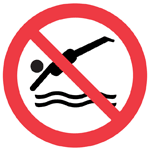Water Safety for Children and Young People
- Available to download: Water Safety for Children and Young People (PDF 232kb) from rospa - The Royal Society for the Prevention of Accidents.
During the school holidays, and in particular in hot weather, increasing numbers of children put themselves at risk of drowning. On average 40-50 children drown per year in the UK.
To keep yourself safe, when you are in, on or beside water, always follow the Water Safety Code.
The Water Safety Code
Spot the dangers!
Water may look safe, but it can be dangerous. Learn to spot and keep away from dangers. You may swim well in a warm indoor pool, but that does not mean that you will be able to swim in cold water.
The dangers of water include:
- it is very cold
- there may be hidden currents
- it can be difficult to get out (steep slimy banks)
- it can be deep
- there may be hidden rubbish, e.g. shopping trolleys, broken glass
- there are no lifeguards
- it is difficult to estimate depth
- it may be polluted and may make you ill

Take safety advice!
Special flags and notices may warn you of danger. Know what the signs mean and do what they tell you.
Learn about water safety signs and the flags you should look out for on the beach.
Go together!
Children should always go with an adult, not by themselves.
An adult can point out dangers or help is somebody gets into trouble.
Learn how to help!
You may be able to help yourself and others if you know what to do in an emergency.
If you see someone in difficulty, tell somebody, preferably a Lifeguard if there is one nearby, or go to the nearest telephone, dial 999, ask for the Police at inland water sites and the Coastguard at the beach.
Find out about rescue methods.
Want to know more?
Now you know the Water Safety Code, try our Water Wise Quiz or look through our water safety information sheets.
Further information & resources
- The Royal National Lifeboat Institution
- The Royal Life Saving Society
- MCA Kids' Activity Zone
.png)
.jpg)